Roseslugs are the immature stages of primitive wasps called sawflies. Roseslugs look more like caterpillars than slugs. They are not slimy and do not have rasping mouthparts like true slugs. Roseslugs differ from caterpillars in that their abdominal legs do not have hooklike crochets to cling on to foliage or twigs. There are several species of sawflies that have been reared from roses in North America. Of these three species appear to cause the most damage: 1) The bristly roseslug, Cladius difformis (Panzer), 2) The roseslug, Endelomyia aethiops Fabricius, and 3) The curled roseslug, Allantus cinctus Linnaeus.
The bristly roseslug is found in Europe, Siberia, and in North America in Nova Scotia, Quebec, Atlantic Coast to British Columbia and down into southern California, It does not appear to occur in warm climates. This roseslug is pale green in color and is covered with many hairlike bristles all over the body. A full grown larva measures up to 16 mm (5/8 inch). The females are about 5/8 inch long and are shiny black with yellowish-orange markings on the body. The males are much smaller, about 3/8 inch long. The young larva begins feeding as a skeletonizer on the underside of the leaves and as it matures it chews large holes on the leaves. There are as many as six generations each year.
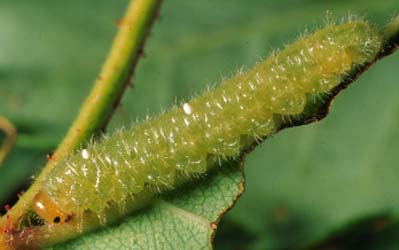

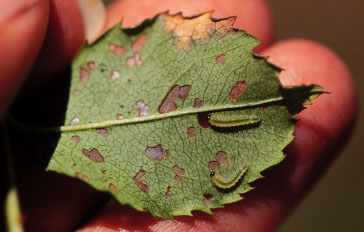
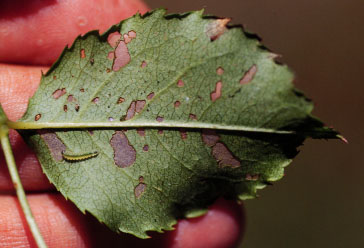
The European roseslug is found from California north to British Columbia and east to Quebec and the Atlantic Coast. It is also found in Europe. The adult sawflies are shiny back with a few yellow makings on the body. They measure about 3/8 inch in length. Females deposit their eggs singly in pockets along the margins of the leaves with their sawlike ovipositor. The larvae skeletonize the upper surface of the leaves. A full grown larva measures up to 13 mm (=1/2 inch). This species appears to have only one generation per year.

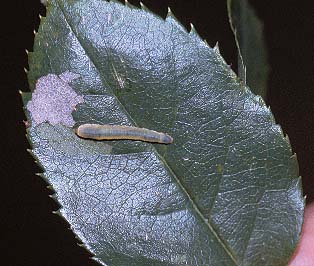
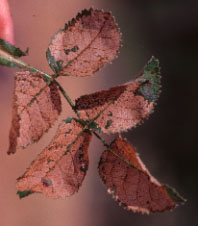
The curled roseslug occurs from California east to the Atlantic Coast. The larva is pastel green dorsally and is marked on the thorax and abdomen with white dots. The head is yellowish with black eye spots. The young larvae starts out by skeletonizeing the leaves and as it matures devours the entire leaves except the main veins. When ready to pupate the larvae bores into the pith of pruned canes. A full grown larva measures up to 19 mm (3/4 inch). In the East Coast there appears to be two generations per year.

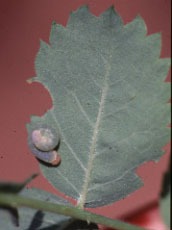

In early June I found bristly rose slugs feeding on wild and cultivated rose bushes in central California and about the same time I found all three species of roseslugs feeding on wild roses in southern Oregon. The curled roseslug was the most distinctive in that it was always curled like a naked snail and attached to the undersides of the leaves. The feeding damage was distinctive in that the mature larvae feed on the margins of the leaves just like the Fuller's rose weevil. The other two species of roseslugs were not as distinctive as I could not see the bristles on the bristly roseslug with the naked eye. However, I found these roseslugs skeletonizing the upper and lower surfaces of the lower leaves of the wild roses.
CONTROL: Rose slugs look like caterpillars but they are not, consequently some insecticides such as Bacillus thuringiensis will not kill them. If there are only a few rose bushes infested with the roseslugs, pull the leaves off and kill any larvae found on the upper or lower surfaces of the leaves. If the damage is widespread to many rose bushes, chemical control should be considered. Any contact or systemic insecticide labeled for use on roses will kill the roseslugs. The key thing is to spray thoroughly to make sure that the spray covers the upper and lower leaf surfaces. Also, spray the soil under the rose bushes as the larvae pupate in the soil prior to overwintering.
Essig, E. O. 1926. Insects of Western North America. The MacMillan Company, NY, p. 768.
Johnson, Warren T. and Howard H. Lyon. 1988. Insects that Feed on Trees and Shrubs, 2nd edition, Cornell University Press, Ithaca, NY., pp 132-3.
Krombein, K. V., et al. 1979. Catalog of Hymenoptera in America North of Mexico. Smithsonian Institution Press, Washington, DC. pp 49, 83, 93, 94, 105, 106, 115.
![]()
If you have any questions or constructive comments, I would love to hear from you, please send e-mail to Baldo Villegas
[Home]
[Rose Pests Master List]
[Rose Diseases]
[Insect, Mites, and other Animal Pests]
[Abiotic Rose Problems]
[Weed Pests]
[Hawaii Pests]
[The Good Guys]
[Help! Rose IPM]
[Horticulure Links]
Copyright© 1995-2005 by Baldo Villegas
Last updated:
Wednesday, October 26, 2005 10:14 PM